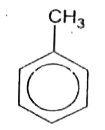(A)(Hydrated salt)Storngly−−−−→heatedB+Ctransparentglassy bead
H3BO3Strongly−−−−→heatedC+D
Find the number of tetrahedral and trigonal planar units in structure of A -
2,1
2,2
2,4
5,2
The correct Answer is:B
To solve the problem, we need to analyze the reactions and structures involved in the transformation of the hydrated salt (A) and the orthoboric acid (H₃BO₃). Let's break it down step by step.
Step 1: Identify the Compounds
- Compound A: The hydrated salt is identified as borax, which has the formula Na₂B₄O₇·10H₂O.
- Compound C: The product formed upon heating is B₂O₃ (boric anhydride).
- Compound B: The transparent glassy bead formed during the heating process.
Step 2: Write the Reaction for Orthoboric Acid
The reaction for orthoboric acid (H₃BO₃) upon strong heating can be written as:
H3BO3heat−−→B2O3+H2O
This shows that heating H₃BO₃ produces boric anhydride (B₂O₃) and water.
Step 3: Write the Reaction for Hydrated Salt (A)
The reaction for borax (A) upon strong heating can be written as:
Na2B4O7⋅10H2Oheat−−→B2O3+Na2B2O5+H2O
This indicates that borax decomposes to form boric anhydride (C) and a glassy bead (B).
Step 4: Analyze the Structure of Borax (A)
The structure of borax (Na₂B₄O₇·10H₂O) consists of:
- Trigonal Planar Units: These are formed by the boron atoms in the structure, which are coordinated to three oxygen atoms. In borax, there are 2 trigonal planar units.
- Tetrahedral Units: These are formed by the boron atoms that are coordinated to four oxygen atoms. In borax, there are also 2 tetrahedral units.
Step 5: Count the Units
From the structure of borax, we can conclude:
- Number of Trigonal Planar Units: 2
- Number of Tetrahedral Units: 2
Final Answer
Thus, the number of tetrahedral and trigonal planar units in the structure of A (borax) is:
- Trigonal Planar Units: 2
- Tetrahedral Units: 2
Summary
The final answer is:
- 2 trigonal planar units and 2 tetrahedral units.
---
- Compound A: The hydrated salt is identified as borax, which has the formula Na₂B₄O₇·10H₂O.
- Compound C: The product formed upon heating is B₂O₃ (boric anhydride).
- Compound B: The transparent glassy bead formed during the heating process.
The reaction for orthoboric acid (H₃BO₃) upon strong heating can be written as:
H3BO3heat−−→B2O3+H2O
This shows that heating H₃BO₃ produces boric anhydride (B₂O₃) and water.
The reaction for borax (A) upon strong heating can be written as:
Na2B4O7⋅10H2Oheat−−→B2O3+Na2B2O5+H2O
This indicates that borax decomposes to form boric anhydride (C) and a glassy bead (B).
The structure of borax (Na₂B₄O₇·10H₂O) consists of:
- Trigonal Planar Units: These are formed by the boron atoms in the structure, which are coordinated to three oxygen atoms. In borax, there are 2 trigonal planar units.
- Tetrahedral Units: These are formed by the boron atoms that are coordinated to four oxygen atoms. In borax, there are also 2 tetrahedral units.
From the structure of borax, we can conclude:
- Number of Trigonal Planar Units: 2
- Number of Tetrahedral Units: 2
Thus, the number of tetrahedral and trigonal planar units in the structure of A (borax) is:
- Trigonal Planar Units: 2
- Tetrahedral Units: 2
The final answer is:
- 2 trigonal planar units and 2 tetrahedral units.
Topper's Solved these Questions
- INORGANIC CHEMISTRYBOOK - ALLENCHAPTER - INORGANIC CHEMISTRYEXERCISE - s-BLOCK ELEMENTS
21 Videos
- INORGANIC CHEMISTRYBOOK - ALLENCHAPTER - INORGANIC CHEMISTRYEXERCISE - METALLURGY
22 Videos
- INORGANIC CHEMISTRYBOOK - ALLENCHAPTER - INORGANIC CHEMISTRYEXERCISE - COORDINATION COMPOUNDS & d-BLOCK COMPOUNDS (MATCH THE COLUMN)
2 Videos
- HYDROGENBOOK - ALLENCHAPTER - HYDROGENEXERCISE - EXERCISE-5
17 Videos
- Ionic EquilibriumBOOK - ALLENCHAPTER - Ionic EquilibriumEXERCISE - All Questions
37 Videos
Similar Questions
underset(("Hydrated salt"))((A)) underset("heated")overset("Storngly")tounderset("glassy bead")underset("transparent")ubrace(B+C)
H3BO3Strongly−−−−→heatedC+D
Identify C-
View Solution(A)(Hydrated salt)Storngly−−−−→heatedB+Ctransparentglassy bead
H3BO3Strongly−−−−→heatedC+D
Find the number of water of crystallizations in (A) :-
View Solution
Knowledge Check
Phenol Zn-dust−−−→AConc.HNO3−−−−−−→+H2SO4BZn−−−→NaOHC
in the above reaction A, B and C are :Abezene,nitrobenzene and anilineBbenzene , dinitrobenzene and m-nitroanilineCbenzene, nitrobenzene and hydrazobenzeneDtoluene, m-nitrobenzene nd m-toludineCH3−CH3∣C∣CH3−C∣BrH3Major product (A) is CH3−EtoH−−→Δ(A)
A B
B C
C D
D
(A)(Hydrated salt)Storngly−−−−→heatedB+Ctransparentglassy bead
H3BO3Strongly−−−−→heatedC+D
How many X–O–X linkages are present in structure of A (X = central atom)-
View SolutionCH3−CH3∣C∣CH3−C∣BrH−CH3El mechanism−−−−−−−−−−→Δ(A)
Major product (A) is
View Solution Br2−−→hv(A)1.KCN−−−−−−−→2.H3O,heat(B)
Br2−−→hv(A)1.KCN−−−−−−−→2.H3O,heat(B)
Calculate no. of carbons in B−−−−−−−−−−−−−−−−→Degree of unsaturation in B
View SolutionIdentify the product A,B,C and D
C6H6CH3Cl−−−−−−−−→Anhyd. AlCl3ACrO2Cl2−−−−→CCl4BConc.−−−→NaOHC+D.
View Solution2CH3−C∣∣O−CH3Mg/Hg−−−−→H+ Product in the reaction is
View Solutionp-Nitro phenol(X)(C2H5)2SO4/NaOH−−−−−−−−−−−−−→(1)Sn/HCl−−−−→(2)(Y)NaNO3/HCl−−−−−−−→(3)C6H5OH−−−−→(4) product is :
View Solution
